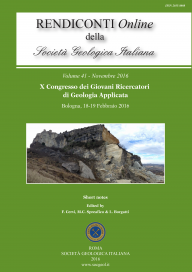
Rockfall susceptibility assessment of carbonatic coastal cliffs, Palinuro (Southern Italy)
Valerio Sorrentino (a), Battista Matasci(b), Antonio Abellan (b), Michel Jaboyedoff (b), Ermanno Marino (c), Antonio Pignalosa (c) & Antonio Santo (d)
(a) Dipartimento di Scienze della Terra, dell'Ambiente e delle Risorse (DISTAR) Università di Napoli Federico II, Naples, Italy E-mail: valerio.sorrentino@unina.it
(b) Institute of Earth Sciences (ISTE), Faculty of Geosciences and Environment, University of Lausanne, 1015 Lausanne, Switzerland
(c) Stage srl, Viale Gandhi 72, 81025, Marcianise (Caserta), Italy
(d) Dipartimento di Ingegneria Civile, Edile ed Ambientale (DICEA) Università di Napoli Federico II, Naples, Italy
Volume: 41/2016
Pages: 203-206
Abstract
This short note presents an approach to assess rockfall susceptibility based on terrestrial laser scanner (TLS) point cloud data at the cliff scale. The test area is coastal cliff situated in the southern part of the Campania Region (Centola Municipality, SW Italy), in which a natural arch was formed. Since this coastal area constitutes an important tourist attraction, a large number of people rest on a daily basis beneath the cliffs, increasing considerably the risk associated to rockfalls. The Terrestrial Laser Scanner (TLS) survey of the cliff was realized in june 2015. A structural analysis of the cliff was performed on the point cloud using Coltop 3D software. The different characteristics defining the discontinuity sets were extracted, including orientation, spacing and persistence. The kinematically unstable areas were mapped using a script that computes an index of susceptibility to rockfalls based on the spatial distribution of failure mechanisms. Results show that the kinematically feasible failures are not equally distributed along the cliff. The most important discontinuity set in terms of potential planar failure is K10 (71/097), for the toppling is K1 (60/218). The combination of K10 and K1 has the highest value of susceptibility for wedge failure.
Keywords
Get Full Text